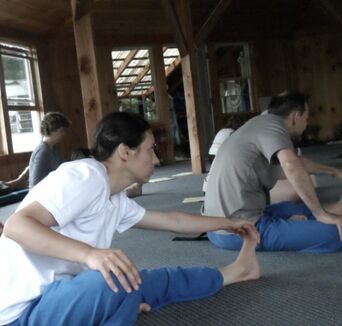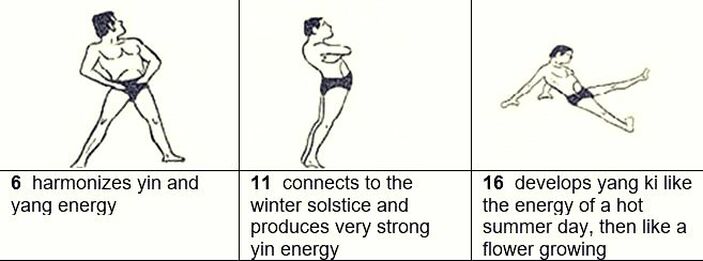Heaven, Earth and Human Unite
BECOMING ONE IN TAOISM WITH SUNDO'S THIRD PRACTICE LEVEL
The Korean Taoist practice of SunDo includes 360 postures performed with deep breathing meditation. The first 50 postures reflect the cycle of the five elements, explored here in a previous blog, Five Element Postures from Earth and Nature. The next 23 postures constitute SunDo’s third practice level, or Keon Gon Dan Boup, explained briefly within this blog, Heaven and Earth Postures: The Taoist Balance of Opposites. We now begin an in-depth look at why the postures in level three are believed to unite us with both heaven (celestial) qi and earth qi.
|
In the West, we live in a world of dualisms — dualisms that carry the weight of heavy judgments. Be generous; not selfish — be active; not passive — be strong; not vulnerable — be a success; not a failure. This is a world of black and white. There is a clear “good” and “bad” in all situations.
Eastern philosophy, particularly within the Taoist tradition, sees things differently. The universe around us is a perfect whole so all opposites are not only inseparable but necessary. |
We cannot truly be generous to others if we do not take time to tend to ourselves. We cannot have meaningful activity without periods of rest. We cannot understand true strength without allowing ourselves to be a little vulnerable. And many of the victories we’ve enjoyed could not have been achieved without the failures that shaped us along the way.
This belief in necessary opposites is captured by the familiar Yin and Yang symbol. Among many things, yang symbolizes activity, expansion, light, and heat, and its perfect opposite, yin, symbolizes stillness, contraction, darkness, and cold. None of these qualities would have any meaning without the existence of their opposites, and the Yin and Yang symbol cannot be whole without representing both extremes.
|
SunDo, an ancient Taoist art native to Korea, contains the necessary tools in its third level of practice to unite dualisms and cultivate wholeness on the physical, mental, and spiritual levels. Taoist scholar Ron Catabia says of the third level postures with rhythmic breathing, “All stages of SunDo practice engage yin and yang ki [or qi in Korean]. However, the stage called Keon Gon Dan Boup, is primarily directed at developing and harmonizing yin and yang energy in the human body.”
This harmonization gently removes the boundaries between mind, body, and spirit and provides a path towards human wholeness and oneness with the universe. |
Restoring Balance Within
SunDo’s third practice level cultivates a sense of equilibrium in the body through the unification of yin and yang energies. Some of us are too high-strung, constantly in a state of excessive yang-like energy — we spend our days running from one obligation to the next, giving ourselves no time to breathe. When free moments do come to us, we just can’t sit still; we can’t refrain from activity. For other people, too much yin creates a sluggish state where simply moving their bodies or taking action can feel like an insurmountable challenge.
These are both examples of how our yang or yin energies can become too dominant. Both soothing yin and energizing yang postures in the third level set offer a holistic treatment to all types of energy imbalances, allowing practitioners to approach any situation with consistent physical calm, and the ability to summon vigorous energy as needed.
Harmonizing the Individual with the Whole
Human beings aren’t the only things that have yin and yang energies — all things and all aspects of the natural world have their own unique energy configurations. Times of day, the seasons, hot and cold — these are all common environmental conditions that can have significant impacts on how we’re feeling.
SunDo’s third practice level cultivates a sense of equilibrium in the body through the unification of yin and yang energies. Some of us are too high-strung, constantly in a state of excessive yang-like energy — we spend our days running from one obligation to the next, giving ourselves no time to breathe. When free moments do come to us, we just can’t sit still; we can’t refrain from activity. For other people, too much yin creates a sluggish state where simply moving their bodies or taking action can feel like an insurmountable challenge.
These are both examples of how our yang or yin energies can become too dominant. Both soothing yin and energizing yang postures in the third level set offer a holistic treatment to all types of energy imbalances, allowing practitioners to approach any situation with consistent physical calm, and the ability to summon vigorous energy as needed.
Harmonizing the Individual with the Whole
Human beings aren’t the only things that have yin and yang energies — all things and all aspects of the natural world have their own unique energy configurations. Times of day, the seasons, hot and cold — these are all common environmental conditions that can have significant impacts on how we’re feeling.
|
Some of us just aren’t morning people; some of us have difficulty staying alert as the day progresses, and many of us find falling asleep to be a great challenge. Some of us are always hot or cold, and we can often feel depressed or more energetic at certain times of year.
These are ways that our internal conditions can be out of sync with the yin and yang energies of the world around us. SunDo’s third level postures allow us to adjust the energy balance between our bodies and the outside world, cultivating greater adaptability in any life situations we encounter. |
Connecting the Conscious to the Unconscious
The balance of yin and yang energy can also become disturbed within the domain of the mind. During most of our waking hours, yang energy dominates as the energy of conscious thought, action, and apparent self-knowledge. This makes sense as we need to act with intention to accomplish our necessary tasks during the day. However, this yang emphasis causes us to lose touch with our subconscious yin side. We may find that we’re missing some hidden details in our lives that leave us feeling confused and unsettled.
The yin energies of the mind relate to unconscious thought, dreams, fantasies, and hidden drives and desires. The Swiss psychiatrist and psychoanalyst Carl Jung was particularly interested in these often repressed corners of the mind, which he referred to as “shadow.”
Catabia writes, “Jung believed that if we want to find wholeness in our lives then we must face our Shadow and understand its contents. We move toward wholeness when we integrate the Shadow into our conscious mind.”
Catabia writes, “Jung believed that if we want to find wholeness in our lives then we must face our Shadow and understand its contents. We move toward wholeness when we integrate the Shadow into our conscious mind.”
|
The SunDo third level postures along with visualization and rhythmic breathing intuitively bring the conscious and unconscious minds together. Long-dormant energies stored within both mind and body are activated within us illuminating past concerns, negatively patterned behaviors, traumas, or repressed emotions. These are then re-integrated into our conscious persona allowing the mind greater balance and peace.
This synthesis is deeply reminiscent of Taoism’s pursuit of wholeness, and SunDo’s third level fittingly provides a powerful tool for doing this challenging “shadow work.” |
Enriching the Spirit
Yin and Yang is also thought of as the divine balance between earth (Gon) and heaven (Keon), and this is reflected in the 22 postures that comprise SunDo’s third level practice. The complete set, based on the formation principle of the universe, includes 10 celestial stems, associated with yang energy and upward movement, and 12 terrestrial branches, associated with yin energy and downward movement.
As mentioned above, everything in nature has its own energy and spirit. The celestial stem and terrestrial branch postures represent different dimensions of nature’s spirit and unite human beings with these important energies. We might liken this desired balance of heaven and earth energies to Hatha yoga’s aim to achieve harmony between the various energy currents — notably the upward-seeking current of liberation and the downward-seeking current of manifestation. These spiritual energies need to be in balance for a person to achieve higher states of consciousness. If the liberation current is weak, a person will not be able to open themselves to intuition, new possibilities and horizon-broadening ideas. However, if the manifestation current is blocked that person will have difficulty actualizing their ideas in concrete reality.
Similarly, for us to achieve our full potential as natural beings rooted in this universe, we need to open ourselves to the energies that both ground us in this world and pull us toward the divine. The celestial stem and terrestrial branch postures give practitioners an opportunity to reconnect on deep level with this important balance of spirit that influences all of our actions.
Bringing Harmony to a World Yearning for Balance
|
These days we see dualisms growing in number everywhere around us — “this side versus that side” — “what they believe versus what I believe.” We’ve become hardened in our judgments and inflexible in our big picture view of things, sinking deeper into self-imposed isolation and distrust of our fellow human beings and the world as a whole.
What we misunderstand is that the great corrective change we wait for doesn’t begin outside of us, but within — by taming the imbalance inside and actualizing harmony outside of ourselves. SunDo’s third level postures hold the power to soften these barriers by starting right with the sources of conflict (ourselves) and changing us through complete mental, physical, and spiritual transformations. |






